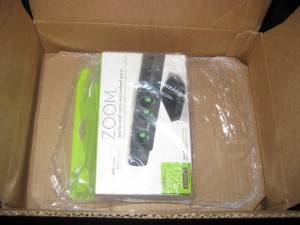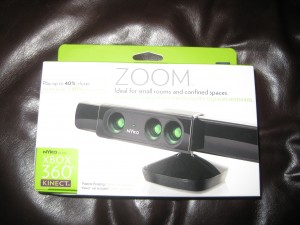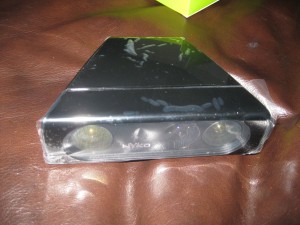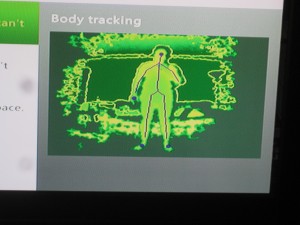As regular readers of this blog may know, I’ve been very excited about the Nyko Zoom. This is a rather clever attachment to the Xbox Kinect that effectively expands your Kinect play area. If you live in a small room or apartment like me, you’ve no doubt been frustrated when you pop in a game and everything works perfectly EXCEPT that the system keeps telling you to step back and there’s no more room for you to step back without tripping over a sofa or hitting a wall.
I received my Nyko Zoom a few days ago from Amazon. Happily, I paid $29.99 to preorder it, but when the price fell to $24, Amazon paid me the difference.
The box came impeccably packaged as Amazon boxes always are.
The box was smaller than I thought it’d be. It’s about the size of a lunch box on an airplane.
After taking out the documentation (a large, folded instruction manual and a separate sheet of paper that seems like it was added after the fact instructing users to “Ensure All Lenses Are Flush”). Evidently, in some of the units, the lenses might pop out of the Zoom. Mine looked okay, however. The Zoom itself is a piece of plastic which is black and glossy to match the Kinect Sensor, with three lenses to match up to the three lenses on the Kinect Sensor, and a small lens where the green LED “on” light shines through.
The first thing you have to do is peel all the protective plastic off the Zoom. They also include a piece of clear plastic that your put ON your Kinect, to protect it from scuff marks from putting the Zoom on and taking it off. I would strongly, strongly recommend you take this step before you do ANYTHING, as I got unsightly scratch marks immediately just after one time putting on the Zoom.
Installation is a snap (literally). You have to line up the three lenses of the Kinect with the three lenses of the Zoom and then snap it on. The Nyko Zoom acts like “glasses” for the Kinect. You need to visually check that the lenses line up. The Zoom will “snap” into place–if there’s wiggle room, you need to try it again.
I started up Kinect Sports. The system didn’t recognize me at all. Even when I waved, it didn’t see me no matter where I stood. I let out a little groan. Maybe the promise of the Zoom was too good to be true. That’s when I decided to read the manual.
The manual says to place the Kinect Sensor 2-6 feet from the ground. That was my first mistake–I had the sensor mounted on top of the TV. Surely enough, when I moved the sensor to the bottom of the TV, Kinect Tuner recognized me. I could see that the camera was indeed picking up my whole body, even though I was only four feet away. Just to be safe, after I finished the Kinect Tuner, I recalibrated the Kinect using the card in Kinect Sports.
What a difference the Nyko Zoom made. Here’s an image of the Kinect Tuner without the Zoom:
And here’s the Kinect Tuner with the Nyko Zoom and me standing in the exact same spot.
Now for the burning question. Did it work with games? I tried it with the two most popular Kinect games: Kinect Sports and Dance Central. And I’ll be honest, my experience was mixed.
There were times, even after I recalibrated, that the system wouldn’t recognized my hand movements. It might pick them up for a split second, but it’d lose it immediately afterwards. My first indication of this was when I was using the Kinect Tuner, I noticed the “green image” of me was very, very dim, but I’d hoped that it wouldn’t affect game play. But it did.
So I adjusted the lighting in my room. I tried turning on bright lights in the background, but that didn’t help. Then I tried putting lighting behind the Kinect, but that didn’t work either. The setup that worked best was putting bright lights about two feet in front of me and to the side. It also helps, as with regular Kinect without the Zoom, to wear clothes that contrast with the background.
Finally, I was able to get it to work. It seemed to pick up my Kinect Sports movements fairly accurately, although there were some times (such as reaching back to throw the discus) that the system got confused. Similarly, Dance Central seemed to pick up my dance moves fairly accurately, but there was a part of me that had a nagging feeling that none of my moves were being picked up as well as they would have been without the Zoom.
A few days later, I did a semi-scientific test which confirmed my feelings. I danced to “Evacuate the Dance Floor”, a song I had never played before. I calibrated the system with the Zoom. With natural lighting only, the top score I could muster was 61,160. With natural lighting plus the room lights flooding my room with brightness, the best score I could get was a 98,474 (and this was after trying MANY times). When I took the Zoom off and played just with the Kinect, I easily scored 124,261 the first time I tried (and this was with my legs cut off). So while technically the Zoom seems to do a good job of expanding the visual space, it’s simply not as good as using the Kinect by itself. Unless, perhaps, you have the PERFECT lighting and contrast (i.e., wearing black clothes against a white wall with a spotlight shining on you).
When it came time to see the pictures taken during gameplay, I could see clearly what the Zoom does. It actually uses a “fisheye” lens to provide a wide field of view for the Kinect. This explained why certain moves weren’t working right–any movement you make forward-and-back and to the extreme sides may end up distorted. Other publications have reported that ironically, while the Zoom will pick up movements 4-6 feet away, it stops working at distances of 7-8 feet. In other words, if you have a poor experience playing, just moving closer. And don’t expect that this will improve multiplayer play at all. This is strictly something for apartment dwellers like me.
And so, to sum up? I’d say the Nyko Zoom is a fantastic and much needed invention, but it has some major faults which I find very disappointing. Overall I was able to play Dance Central and Kinect Sports, something I could not do before without moving my sofa completely out of the way. But the pickup of the camera is definitely compromised, and you may find that it doesn’t affect gameplay at or OR that it affects it tremendously, depending on the game and your room’s lighting. I’d say your best bet is still to do whatever you can to move or mount the Kinect sensor so that it’s a full 7-10 feet away. But if that’s simply impossible, the Zoom is worth a shot, especially at under $25, as long as you have the patience to move the location of the sensor, calibrate it, and fiddle with the lighting until it works.
As such, it’s hard to give this a rating. I personally would give it 3 of 5 stars, but depending on your circumstances and your lighting, your results may different dramatically. Looking at game sites, a lot of people rave (and publications) rave about it, while a lot of users are expressing profound disappointment.






With the living spaces being so limited in Europe buying the Zoom was a must to even think about having a chance to work with Kinect. A lot of the same issues of not being recognized and did move the lighting but it turned out that turning the lights off made it better. Otherwise the sensor lost me half of the time. Still from time to time I have a problem choosing menus. At least last night it was fun with two players maybe tonight I will be better as just one player.